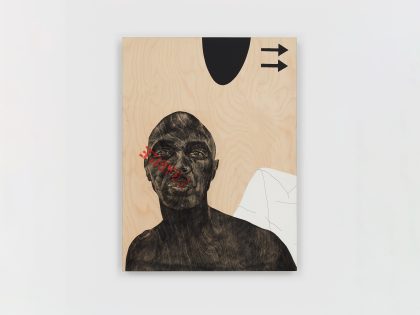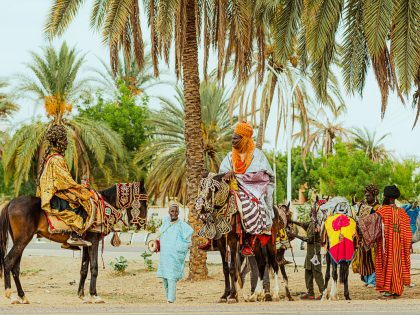Maboneng is on fire
David Adjaye’s plans to 'revitalize' Hallmark House in downtown Johannesburg, raises ethical questions about the city's development plans.

I was retweeting things like “It was only a matter of time #Maboneng” after someone was shot in the head during the eviction protests in Jeppe; that afternoon on my way home from work I was ducking and diving to dodge a burning Bridgestone in the middle of Marshall Street in Johannesburg. Then the following day, news came of David Adjaye’s plans to ‘revitalize’ Hallmark House, the latest Maboneng precinct project.
The redevelopment of the industrial high-rise is the first time that the Tanzanian born, London-raised world-renowned architect has undertaken a project in southern Africa. His firm, Adjaye Associates, has previously done work on the Peace Center in Oslo, the Moscow School of Management, the Msheireb Downtown district in Doha and the National Museum of African American History and Culture in Washington, D.C
Gut reaction: This is like watching a bullet coming towards my head in slow motion. The irony is like a ball of frustrated resignation in the pit of my stomach, a similar feeling aroused by ‘ghost squads’ of plainclothes police cruising along Siemert Street pointing automatic rifles out of the open doors of police minibuses at the window washers at intersections. Incidentally, this is the location of the soon-to-be-transformed 17-storey building. At times, the latent trauma of ‘revitalization’ feels like what I imagine a crime novel by Samuel Beckett to be: a surreal, felonious theatre of the absurd centered around questions of economic development, social justice, who-is-most-to-blame and of course, WTF to propose as a solution to human beings trapped in an incomprehensible world subject to any occurrence (like property developers playing Monopoly with homes).
Second reaction after rant against God in the style of Frank Gallagher shouting at the sky: But actually, my Dad is probably going to tell me about this, surreptitiously imploring me to think it’s cool to look at buying one of these properties. He will sell me dreams of Hallmark House’s gym, onsite spa, café, swimming pool and outdoor cinema (part of the Bioscope brand of cinema currently running in Maboneng.) My Mom will chime in: “Units are already on sale from R495 000 (premium apartments are expected to sell for about R2 million) which could totally be an investment for you. Did you watch the budget speech? Do you know the new housing rates eliminate transfer duty on properties below R750 000?”
And part of me will get excited thinking about a rooftop balcony with plants and Smack! microbrewery and Firebird roaster (confirmed tenants in the building, I don’t know what they are but I imagine they are craftily delicious). My imagination carried me away to a fantastical world reminiscent of the Sims-style rendering of the building plans, the kind of place where I can solve all my problems like white women in a romantic movies, by eating a giant tub of ice-cream or drinking tea by the window while wearing an oversized sweater (visual image courtesy of @fastingcannibal).
BUT! What about the people?! How do I upgrade my lifestyle to that dream world, while my neighbors set theirs on fire? Jonothan Liebemann, CEO of Propertuity, which is behind the Maboneng developments, put it best: “Property is a high-impact industry, it changes people’s lifestyles. At Propertuity we approach this industry with ideas that people say are impossible, that are crazy and won’t work.”
It is certainly a crazy idea for me to lament ethical consternation about buying into gentrification to my parents, because they want me to make the most of the opportunities on hand, especially ones they weren’t allowed. It didn’t work when I quoted a previous AIAC article: “But guyssss, the intersection between the individual and the city presented by the Maboneng ‘regeneration project’ (gentrification is too suitable and honest a word)… is a strictly curated experience that takes place along clearly delineated class lines. Class lines that keep some in and most others out.” My folks be like: GET IN THERE!
I then quoted my guy, Achmat Dangor: “It struck me that our history is contained in the homes we live in, that we are shaped by the ability of these simple structures to resist being defiled” and began to explain the irksome feeling I got about this celebrity architect. Describing the influence of having lived in Tanzania, Egypt, Yemen, Lebanon and England (his father was a diplomat), he says things like “I was forced from a very early age to negotiate a wide variety of ethnicities, religions, and cultural constructions. By the time I was 13, I thought that that was normal, and that was how the world was. It gave me a kind of edge in an international global world.” And that this edgy African-British identity also gives him an altered perspective from others in the profession because he is “not just not always looking at the usual references.” The aim of this particular passion project is to “combine an African aesthetic with a contemporary vision“.
It is still not normal to easily negotiate a wide variety of ethnicities, religions, and cultural constructions in Johannesburg away from quirky bubbles like Maboneng, because of the inherent politico-economic inequality in this society. But again Jon-Jon’s got the answer: “Partnering with Mace will allow us to continue disrupting normality in a significant way.” The introduction of the famed starchitect onto this spatial social scene is interesting indicator of norm disruption because he is a pretty high profile example of “African aesthetic with contemporary vision” (homeboy hobnobs Kofi Annan and Barack Obama). It’s a weird city-narrative development that a celebrity architect is going to be designing what could potentially become my home/hotel/history, in the context of gross urban poverty and inequality. (I could just be sour about the artist renderings of the new building only having beige faces in a black city, but Adjaye just gives me the impression that had he been a rock star in the 80s, he would have performed at Sun City during the boycotts.)
Adjaye’s previous buildings have been described by Rowan Moore as:
Works of a realigned world, where the distribution of money and power ignores former distinctions of third and first worlds. They collectively offer the same reorientation as those world maps that dispense with the Eurocentric bias of Mercator’s projection.
Go figure that he would say something like, “you will look at this building and think that it is in some other city, and then you will realize its in Johannesburg; it’s in Africa.” This makes me uncomfortable. Surely my World Class City can do more than superimposing superstar-structures to prove its progression?
It can certainly do more for inclusive development. Journalist Greg Nicholson describes Maboneng as a symbol and a scapegoat during violent protests, given the controversial debate about its impact in the city and the lack of evidence linking Propertuity to the protest – the buildings where evictions are set to take place are far from precinct, and close to the decrepit local men’s hostel.
According to the City, which held a meeting last week with community leaders and police, there are three private companies trying to evict tenants on three different properties, but some community members say eight buildings have received eviction notices. Propertuity has made it clear that the group is not involved in either buying or evicting from the Jeppe buildings. Maboneng has been steadily growing for years, and the hasty actions of copycat developers are leapfrogging off this success. It is similar to the Chinese concept of “dragon head enterprise”. With the leader of the pack having distanced itself for responsibility, those behind these evictions must be identified and held accountable, while riding the inner-city cash-cow by selling dreams to consumers (like my parents, and of course, the market of young/ professional/ creatives wanting an alternative to suburban Johannebsurg.)
There is some synergy between the City’s approach to development and a critique of Adjaye’s previous public projects: “there’s a tendency for the story behind the design to outrun the realization… there is a disconnect between the parts that speak of public life and interaction.” City planners, developers and designers shape the way that homes and histories are constructed (be it colonial structuring or imported Tuscan villas in gated complexes). This protest is a portent of more to come if the planner-designer-developer triad does not do better with the trendy opportunities at hand and take responsibility for marginalized residents by communicating clearly, presenting options for low-cost inner-city housing, and advocating for inclusive development that goes beyond ‘mixed-income’ hotel apartments and international rappers at street festivals because “a relatively contained protest could soon mushroom into another existential problem for Johannesburg.” Surely we have enough of those already.



















